Summary Inflation Report Consumer Price Index (CPI) (2018=100) Agusan del Norte August 2024
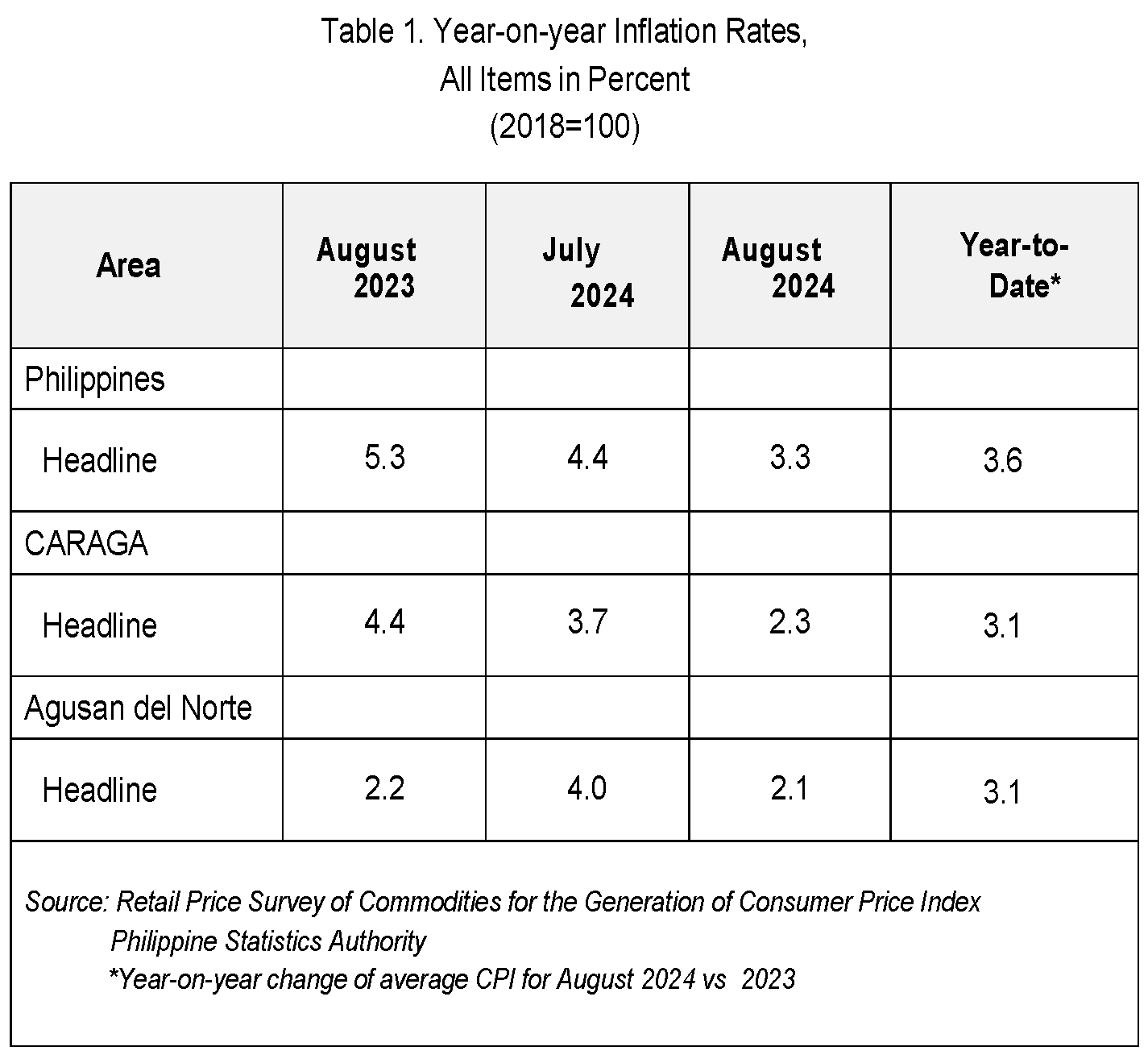
The headline inflation rate in Agusan del Norte dropped at 2.1% in August 2024.
In August 2024, the inflation rate in Agusan del Norte province stood at 2.1 percent, marking a reduction from the previous month's inflation of 4.0 percent. This signifies a modest decrease of 1.9 percentage points compared to the inflation rate in July 2024, and a slight dip of 0.1 percentage points when juxtaposed with the inflation rate documented in August 2023, which was reported at 2.2 percent.
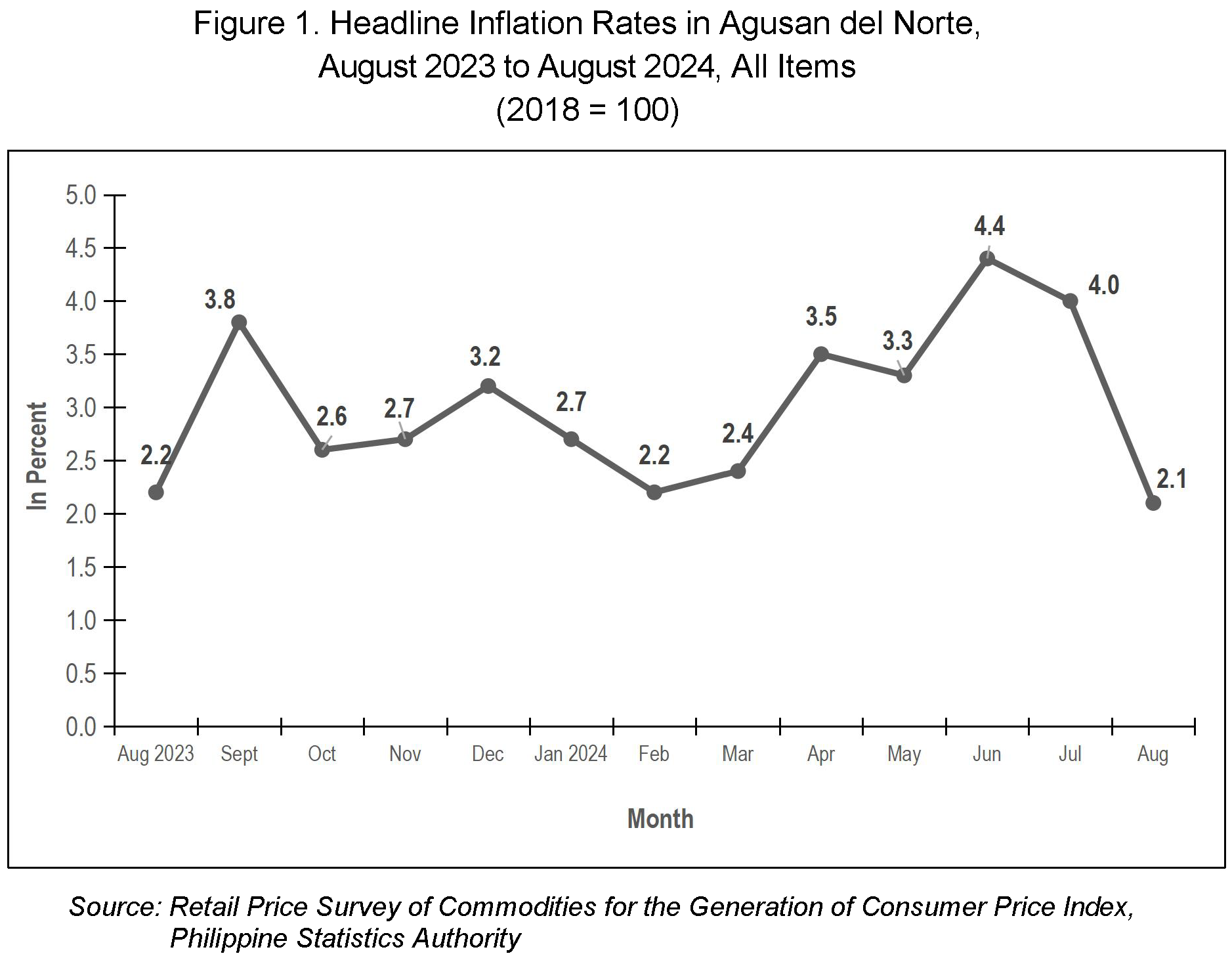
Major Contributors to the August 2024 Inflation
The following groups mainly contributed to this month’s inflation. These are:
1. Food and Non-Alcoholic Beverages; the inflation rate of this category slightly decreased to 6.8 percent from 7.3 percent in July 2024. This particular group made a substantial contribution, representing 161.9 percent of the total inflation for the month.
2. Personal Care, Miscellaneous Goods and Services; this category ranked second on the list, displaying an inflation rate of 2.0 percent, which is 0.2 percent lower than the 2.2 percent inflation rate observed in July 2024. This sector contributed to about 4.2 percent to the overall inflation in Agusan del Norte.
3. Clothing and Footwear; this particular category secured the third position on the ranking, denoting a 2.4 percent inflation rate in August 2024, signifying a marginal uptick of 0.1 percentage points in contrast to the 2.3 percent inflation registered in July 2024. This specific category contributed to roughly 3.4 percent of the overall inflation noted for this period.
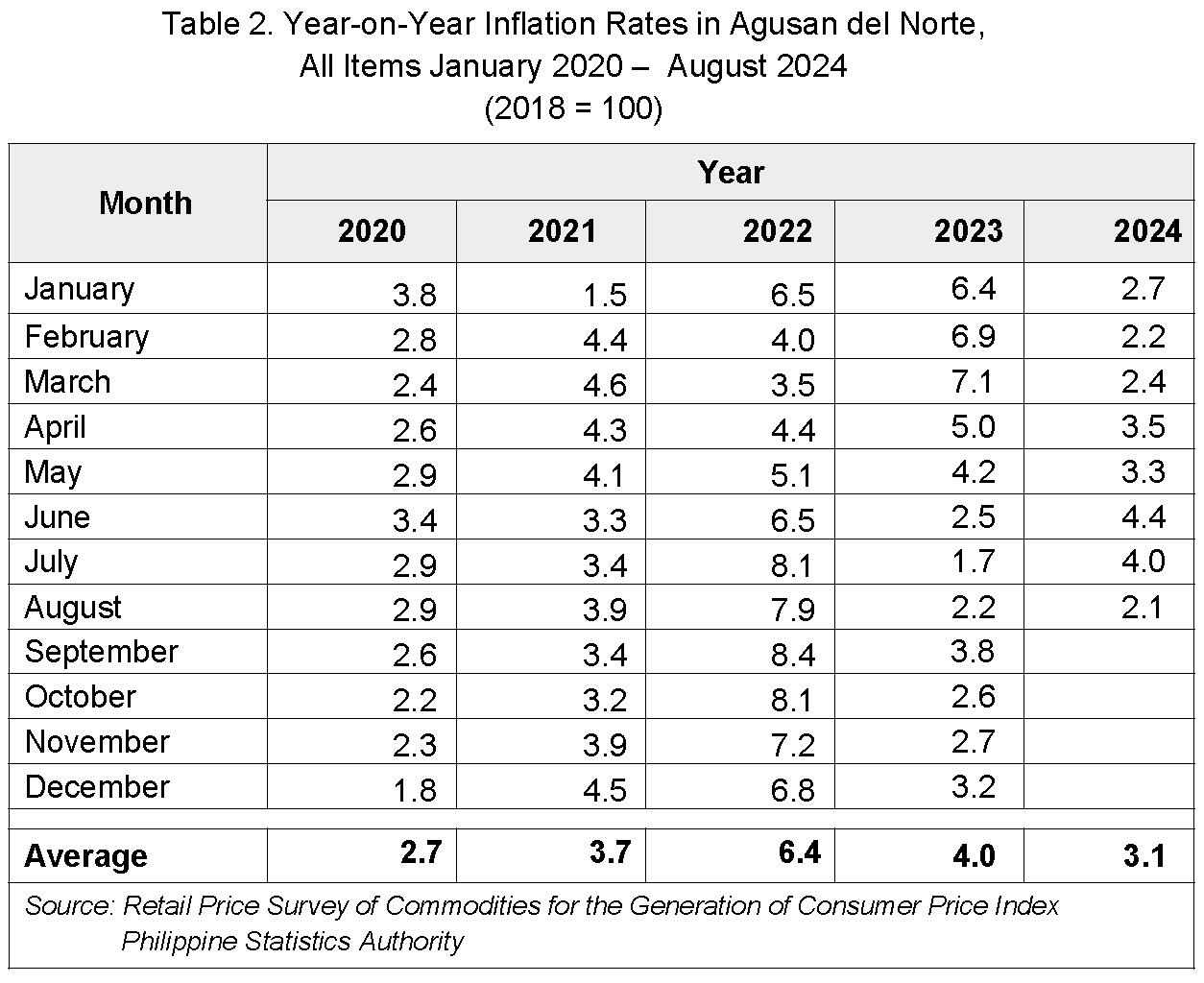
Major Contributor to the Year-on-Year Inflation Trend
Among the thirteen (13) groups of commodities, the following top three (3) groups have made a substantial contribution to the reduction in inflation. These are the following:
1) Housing, Water, Electricity, Gas, and Other Fuels; this group experienced a significant decrease in prices, resulting in a substantial drop in inflation to -8.2 percent from -1.0 percent in July 2024. This category predominantly contributed to 65.7 percent of the reduced inflation rate.
2) Transport; this particular group ranked second in terms of its impact on the inflation trend, with its inflation rate dropping from 1.1 percent in July 2024 to -2.8 percent this month. The decline in the prices of fuels and lubricants for personal transport equipment was the primary factor behind this reduction. This industry contributed to approximately 19.9 percent of the overall inflation trend.
3) Food and Non-Alcoholic Beverages; this sector secured the third position, with its inflation rate decreasing to 6.8 percent in August 2024 from 7.3 percent in July 2024, contributing approximately 12.9 percent to the inflation trend.
Inflation Rate by Commodity Group
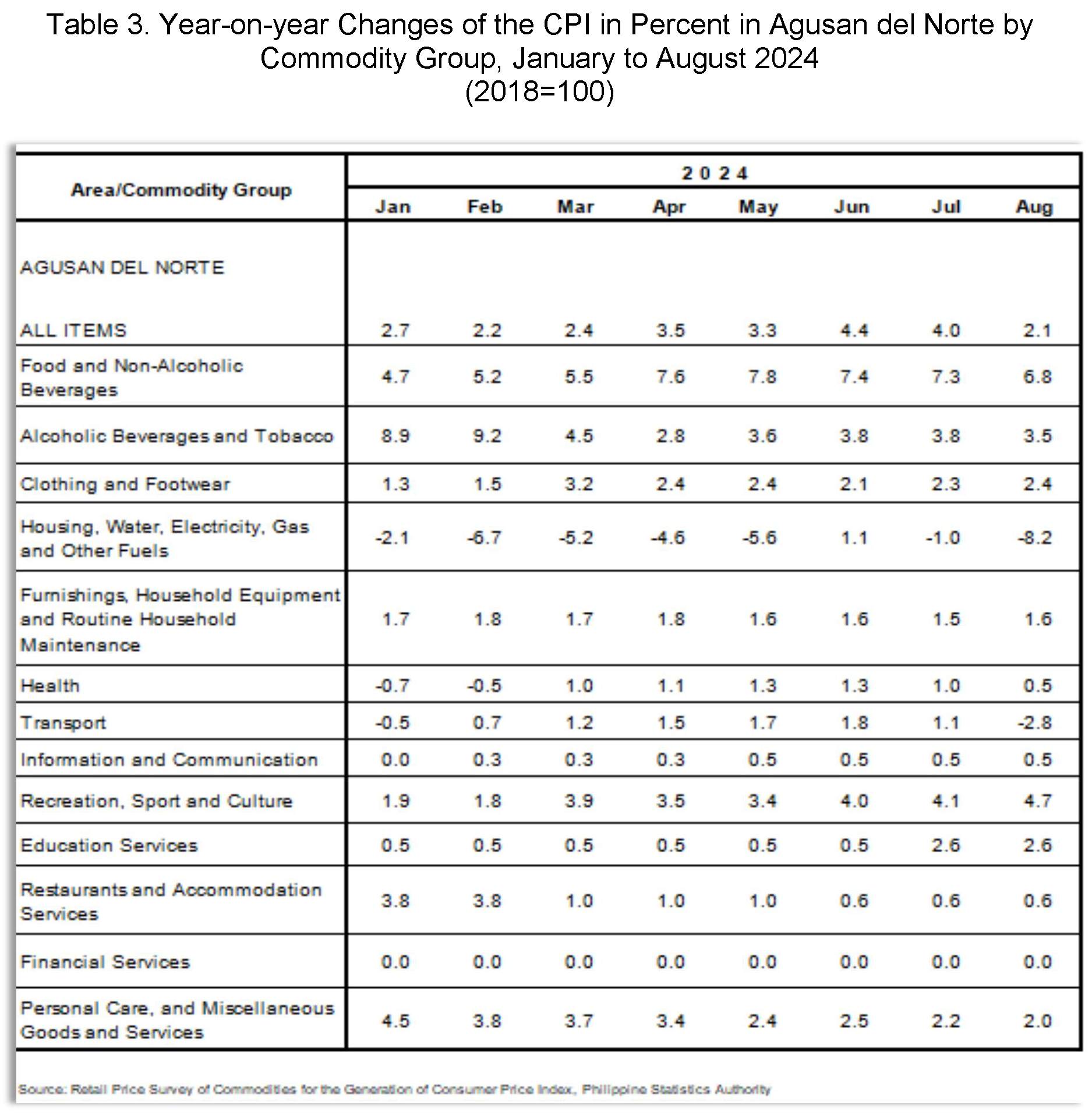
Food Alone Inflation
In August 2024, the province witnessed a decrease in the food inflation rate, which fell to 7.2 percent from 7.8 percent in July 2024. In comparison to the inflation rate documented in the same month of the previous year, this month's inflation has surged by 3.4 percentage points from its recorded rate of 3.8 percent in August 2023. The primary factors contributing to the inflation in the food category are as follows:
1) Cereals and cereal products; This particular food category exert a significant impact on the inflation rate within the food sector. There was a decrease in inflation observed, shifting from 27.6 percent in July 2024 to 25.6 percent in August 2024. The decline in the year-on-year growth rate of rice played a crucial role in this reduction, as inflation rates decreased to 28.4 percent from the previous month's figures of 30.9 percent. Cereals command a substantial 98.7 percent share in food inflation, with rice specifically holding a noteworthy 96.4 percent contribution to food inflation.
2) Milk, other dairy products and eggs; secured the second position in the ranking. This food category experienced a notable increase in inflation in August 2024, rising to 4.3 percent from the 3.8 percent recorded in July of the same year. The surge in prices of fresh eggs was a key factor in driving up inflation within this particular group. Furthermore, this specific food category accounted for a 4.3 percent share of the overall food inflation.
3) Meat and other parts of slaughtered land animals; this food category attained the third position in the ranking. The inflation pertaining to this food group experienced a decline of 0.7 percentage points, registering at 2.0 percent in August 2024 as opposed to 2.7 percent in July 2024. The reduction in the mean prices of fresh pork played a crucial role in the abatement of inflation within this group. Furthermore, this specific food category constituted a significant 3.6 percent portion of the overall food inflation.
4) Ready-made food and other food products n.e.c were positioned fourth in the ranking, exhibiting a significant decrease in inflation of 4.5 percent this month compared to 8.2 percent in July 2024. The decline in the mean prices of specific spices, notably ginger, played a crucial role in the reduction of inflation within this food category. This group accounted for approximately 1.9 percent of the total food inflation for August 2024.
5) Fruits and nuts were ranked fifth on the list, with a significant rise in inflation recorded at 3.1 percent this month from its previous negative inflation of -5.3 percent in July 2024. The surge in the average prices of fruits, particularly mangoes, played a pivotal role in driving up inflation within this food category. This category contributed to around 1.0 percent of the total food inflation for August 2024.
The Purchasing Power of the Peso (PPP) improved at Php 0.82 in August 2024
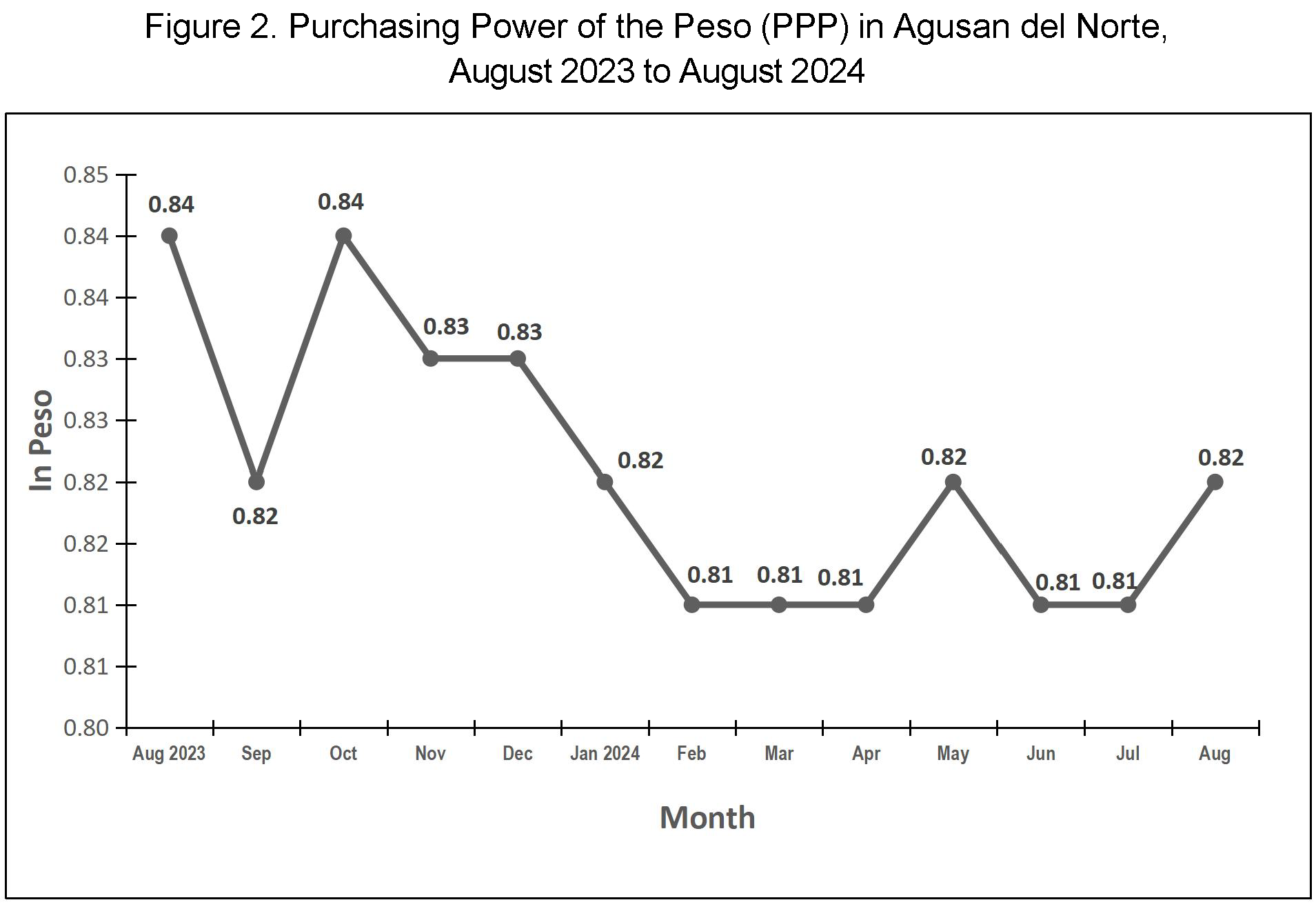
The Purchasing Power of the Peso (PPP) in Agusan del Norte has shown a slight improvement, reaching Php 0.82 in August 2024. This increase in PPP signifies a positive trend in the province’ economic stability. To put this into perspective, let's consider how this uptick in purchasing power can impact the local community. With the PPP rising, consumers in Agusan del Norte may find that their money can now buy slightly more goods and services than before.
TECHNICAL NOTES
The Philippine Statistics Authority generates and announces the monthly Consumer Price Index (CPI) based on the nationwide survey of prices for a given basket of goods and services. Two important indicators, the inflation rate and purchasing power of the peso (PPP), are derived from the CPI which are important in monitoring price stability and the value of the country’s currency.
The Consumer Price Index (CPI) is an indicator of the change in the average retail prices of a fixed basket of goods and services commonly purchased by households relative to a base year. It shows how much on the average, prices of goods and services have increased or decreased from a particular reference period known as base year.
Inflation Rate refers to the rate of change in the average prices of goods and services typically purchased by consumers. It is interpreted in terms of declining purchasing power of money.
Disinflation refers to a situation where the general level of prices is increasing but at a decreasing rate.
Deflation refers to a situation where the general level of prices is falling and the rate is below zero percent.
The Purchasing Power of the Peso (PPP) indicates the value of the peso in the period under review as compared to the value of the peso in the base period. It is computed as the reciprocal of the CPI for the period under review multiplied by 100.
Statistical Table refers to the statistical data presenting a reference table for the CPI, and Inflation Rate of each commodity groups and food items that are used for attachments.
Approved by:
(Sgd.) REYNELO S. MAGNO
Chief Statistical Specialist, PSO – Agusan del Norte
Telephone number: (085) 817-3193 / Telefax No.: (085) 225 – 2097
Email address: agusandelnorte@psa.gov.ph

